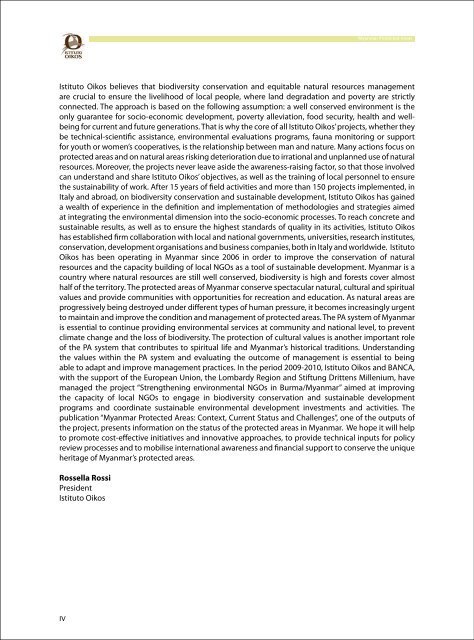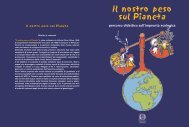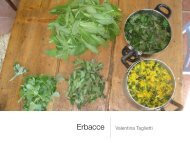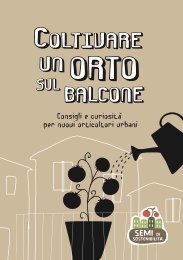Myanmar Protected Areas: Context, Current Status ... - Istituto Oikos
Myanmar Protected Areas: Context, Current Status ... - Istituto Oikos
Myanmar Protected Areas: Context, Current Status ... - Istituto Oikos
Create successful ePaper yourself
Turn your PDF publications into a flip-book with our unique Google optimized e-Paper software.
<strong>Istituto</strong> <strong>Oikos</strong> believes that biodiversity conservation and equitable natural resources management<br />
are crucial to ensure the livelihood of local people, where land degradation and poverty are strictly<br />
connected. The approach is based on the following assumption: a well conserved environment is the<br />
only guarantee for socio-economic development, poverty alleviation, food security, health and wellbeing<br />
for current and future generations. That is why the core of all <strong>Istituto</strong> <strong>Oikos</strong>’ projects, whether they<br />
be technical-scientific assistance, environmental evaluations programs, fauna monitoring or support<br />
for youth or women’s cooperatives, is the relationship between man and nature. Many actions focus on<br />
protected areas and on natural areas risking deterioration due to irrational and unplanned use of natural<br />
resources. Moreover, the projects never leave aside the awareness-raising factor, so that those involved<br />
can understand and share <strong>Istituto</strong> <strong>Oikos</strong>’ objectives, as well as the training of local personnel to ensure<br />
the sustainability of work. After 15 years of field activities and more than 150 projects implemented, in<br />
Italy and abroad, on biodiversity conservation and sustainable development, <strong>Istituto</strong> <strong>Oikos</strong> has gained<br />
a wealth of experience in the definition and implementation of methodologies and strategies aimed<br />
at integrating the environmental dimension into the socio-economic processes. To reach concrete and<br />
sustainable results, as well as to ensure the highest standards of quality in its activities, <strong>Istituto</strong> <strong>Oikos</strong><br />
has established firm collaboration with local and national governments, universities, research institutes,<br />
conservation, development organisations and business companies, both in Italy and worldwide. <strong>Istituto</strong><br />
<strong>Oikos</strong> has been operating in <strong>Myanmar</strong> since 2006 in order to improve the conservation of natural<br />
resources and the capacity building of local NGOs as a tool of sustainable development. <strong>Myanmar</strong> is a<br />
country where natural resources are still well conserved, biodiversity is high and forests cover almost<br />
half of the territory. The protected areas of <strong>Myanmar</strong> conserve spectacular natural, cultural and spiritual<br />
values and provide communities with opportunities for recreation and education. As natural areas are<br />
progressively being destroyed under different types of human pressure, it becomes increasingly urgent<br />
to maintain and improve the condition and management of protected areas. The PA system of <strong>Myanmar</strong><br />
is essential to continue providing environmental services at community and national level, to prevent<br />
climate change and the loss of biodiversity. The protection of cultural values is another important role<br />
of the PA system that contributes to spiritual life and <strong>Myanmar</strong>’s historical traditions. Understanding<br />
the values within the PA system and evaluating the outcome of management is essential to being<br />
able to adapt and improve management practices. In the period 2009-2010, <strong>Istituto</strong> <strong>Oikos</strong> and BANCA,<br />
with the support of the European Union, the Lombardy Region and Stiftung Drittens Millenium, have<br />
managed the project “Strengthening environmental NGOs in Burma/<strong>Myanmar</strong>” aimed at improving<br />
the capacity of local NGOs to engage in biodiversity conservation and sustainable development<br />
programs and coordinate sustainable environmental development investments and activities. The<br />
publication “<strong>Myanmar</strong> <strong>Protected</strong> <strong>Areas</strong>: <strong>Context</strong>, <strong>Current</strong> <strong>Status</strong> and Challenges”, one of the outputs of<br />
the project, presents information on the status of the protected areas in <strong>Myanmar</strong>. We hope it will help<br />
to promote cost-effective initiatives and innovative approaches, to provide technical inputs for policy<br />
review processes and to mobilise international awareness and financial support to conserve the unique<br />
heritage of <strong>Myanmar</strong>’s protected areas.<br />
Rossella Rossi<br />
President<br />
<strong>Istituto</strong> <strong>Oikos</strong><br />
<strong>Myanmar</strong> <strong>Protected</strong> <strong>Areas</strong><br />
Among South-East Asian countries there is no doubt that <strong>Myanmar</strong> is the most biologically diverse<br />
country on the mainland. It possess a long coastal line of 2,000 kilometers, over 800 islands, mangroves,<br />
high mountains of the Eastern Himalayas in the north, a dry zone in the center, Sundaic forest in the<br />
south and many types of habitats and ecosystems. There are only few types of habitats left on earth that<br />
cannot be found in <strong>Myanmar</strong>. It still has a high percentage of natural forest cover which is home to a rich<br />
diversity of flora and fauna. It is also one of the least explored countries in the world. There have been<br />
expressions like“ after walking two days we found nothing but primeval forest”, “ we barely see a person<br />
coming along during our exploration” and “there is one new bird found in every step we took” from<br />
nature lovers and bird watchers who have visited <strong>Myanmar</strong>. The Leaf deer Muntiacus putaonensis and<br />
the <strong>Myanmar</strong> Snub-nosed Monkey Rhinopithecus strykeri are some of the new discoveries within recent<br />
years in the Northern part of <strong>Myanmar</strong>. Other species of reptiles and amphibians new to science have<br />
also been reported. The Ministry of Forestry has been trying to protect representative type of forests<br />
and up till now has gazetted, nominated and proposed 43 protected areas which cover 7.3 % of total<br />
land. But as a developing nation, <strong>Myanmar</strong> has financial as well as environmental issues. Unfortunately<br />
conserving biodiversity and environment is not the top priority of the government. Out of 43 protected<br />
area systems only a few have been properly gazetted and have a management system in place. Some<br />
are nominated and some are only in a proposal stage. Very few of the gazetted protected areas have full<br />
management resources and staff. Even big national parks are short of resources. For them top priorities<br />
like regular biodiversity surveys and patrolling are beyond their capacity. As a result very few parks have<br />
a comprehensive checklist of flora and fauna. Lampi Island Marine National Park falls in the category<br />
that does not have a proper management system and a checklist of flora and fauna that exist in the<br />
park. We BANCA and <strong>Oikos</strong> do sincerely feel honored to conduct this much needed survey which we<br />
hope will help the forest department to form a proper management system and serve as a baseline for<br />
further evaluation and monitoring of this park. Moreover, we also hope that this publication will serve as<br />
a good reference for all existing parks of <strong>Myanmar</strong>. During recent years people have changed. Their new<br />
lifestyle has become more advanced and sophisticated. New changes need new solutions. Population<br />
has also increased dramatically and consequently more space becomes essential for their livelihoods and<br />
sustainability. The more space they need the more destruction was made to nature and the environment.<br />
The lifestyle of people and the changes in the environment have become more interconnected. Issues<br />
have become too big and complicated to be handled by a single department or organization alone.<br />
Therefore people in the conservation field also have to change. All stakeholders including governments,<br />
private and public sectors have to work together to have successful conservation programs. BANCA and<br />
<strong>Istituto</strong> <strong>Oikos</strong> as stakeholders look forward to assist <strong>Myanmar</strong> within our capacity especially in the field<br />
of biodiversity for successful conservations programs. BANCA appreciates the support of international<br />
organizations and the European Union to meet the conservation challenge.<br />
Dr Htin Hla<br />
Chairman<br />
BANCA<br />
<strong>Myanmar</strong> <strong>Protected</strong> <strong>Areas</strong><br />
IV V






